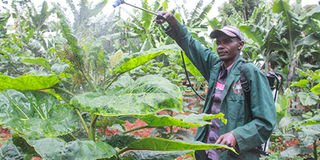Agronomist notebook: The best way to spray crops

Peter Maina sprays tree tomatoes in a farm in Nyeri in this past photo. The central rule in the application of pesticides on crops is to ensure that there is even distribution of the chemical on the foliage. FILE PHOTO | NATION MEDIA GROUP
What you need to know:
- Glyphosate is a compound that is used as herbicides to kill weeds. In this case, the farmer was spraying the chemical to dry the bulb onion leaves within the shortest time possible.
- The central rule in the application of pesticides on crops is to ensure that there is even distribution of the chemical on the foliage.
- Before selecting the equipment to use, it’s important to check the label and the integrated pest and disease guidelines for the particular pesticide that will be applied.
- Choosing a bigger nozzle increases the water volume rate and applies larger drops compensating for the reduced coverage from the bigger droplets.
The increased use of pesticides on farms has raised concerns over the safety of food sold in the markets.
This is because most farmers misuse chemicals knowingly or unknowingly, exposing consumers and the environment to various risks.
The farm chemicals are used at almost all stages of crop growth, right from land preparation where herbicides are applied to clear weeds to planting, during transplanting and until the crop is harvested and stored.
In the course of my work last week, I met farmer Bosire in Meru County, who had sprayed bulb onions that were ready for harvest with glyphosate.
Glyphosate is a compound that is used as herbicides to kill weeds. In this case, the farmer was spraying the chemical to dry the bulb onion leaves within the shortest time possible. He was doing this to be able to sell the onions when the prices are high.
Using such underhand tactics, a farmer is able to make some more money but this is at the expense of consumers since he does not observe the pre-harvest interval period for that particular chemical which has been linked to rise in cancer cases.
High usage of pesticides is not only a threat to the health of consumers but also to the environment due to pollution. To ensure production of healthy foods, farmers should embrace good agricultural practices.
The central rule in the application of pesticides on crops is to ensure that there is even distribution of the chemical on the foliage.
It’s also important to take precaution while spraying a chemical by wearing protective equipment such as gloves, respirators, boots, and overalls. Some farmers also spray at the wrong time, that is when it’s very windy or too hot.
While spraying, it’s important to reduce the wind drift by using a protective guard. This will help avoid crop damage in the neighbouring fields and thus protect the environment.
DONE EARLY IN THE MORNING
Spraying should also be done early morning or late evening when the wind speeds are low. Also, most pests are active at night, making it easy to kill them. A sunny environment results in evaporation of the chemical causing a very minimal effect on the crop.
Before selecting the equipment to use, it’s important to check the label and the integrated pest and disease guidelines for the particular pesticide that will be applied.
The chemical label provides the farmer with a good source of information on how it should be applied. Therefore, read and understand the label.
Choose the nozzle of the spray depending on the wind speed. If the wind is causing a lot of drift, adapt to the situation or postpone the application. Under windy conditions, low pressure is recommended since it produces large drops.
Choosing a bigger nozzle increases the water volume rate and applies larger drops compensating for the reduced coverage from the bigger droplets.
Calibrate your knapsacks or spraying equipment after every fortnight to ensure that all the parts are functioning efficiently.
Now, to spray for instance, tomatoes, it’s important to understand the target pest or diseases since some infestations start on the lower sides of the leaves.
However, while spraying, ensure there is uniform coverage of the pesticide on the plant. Start by spraying the crop from the upper parts, sideways as you move downwards.
The leaves should be sprayed both on the upper and the lower side to increase the chemical efficiency. In some cases, you can spray the base of the plant like when controlling the cutworms in young seedlings.
You are obligated to follow the instructions labelled on the pest control products strictly to avoid toxifying yourself, your family and your farm produce





